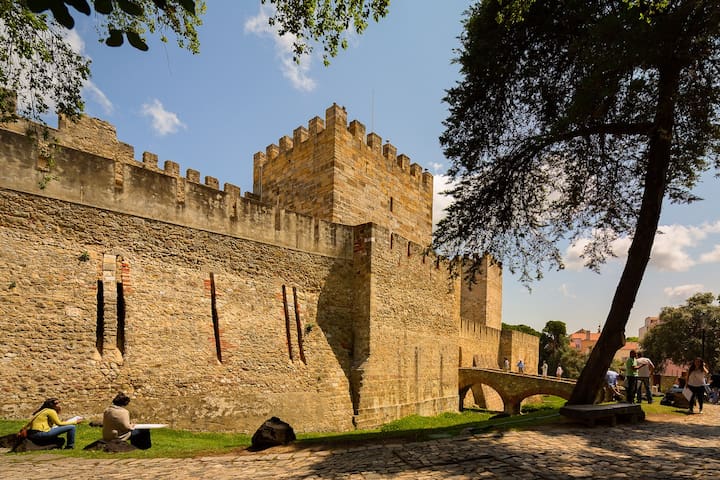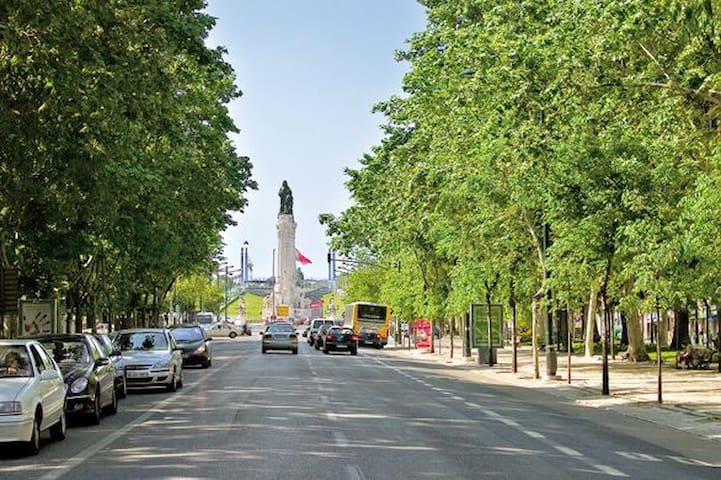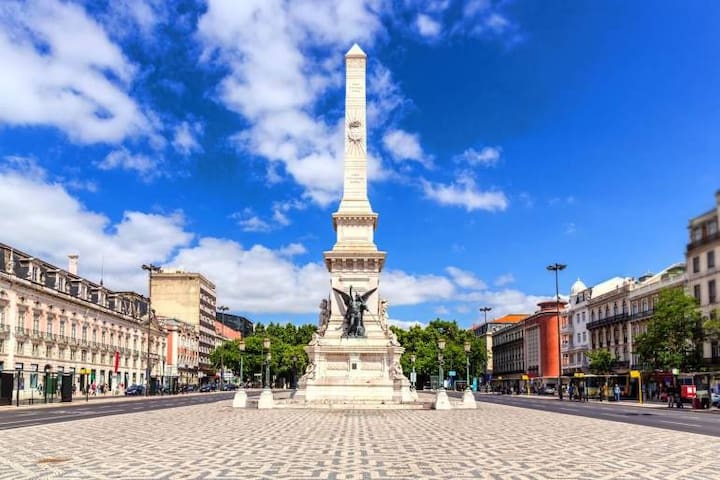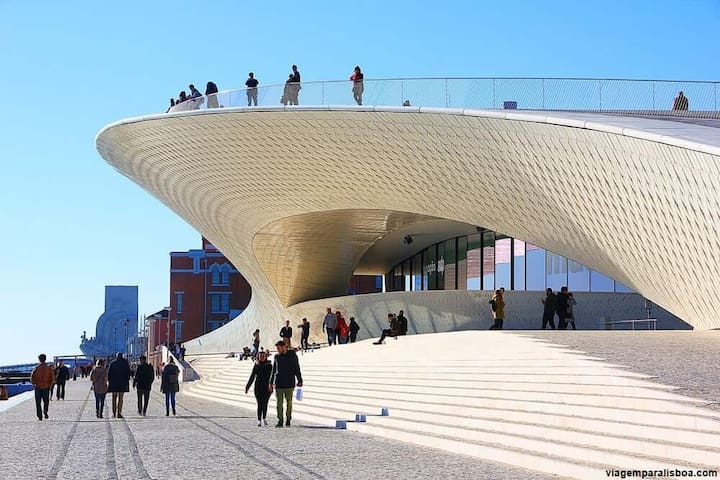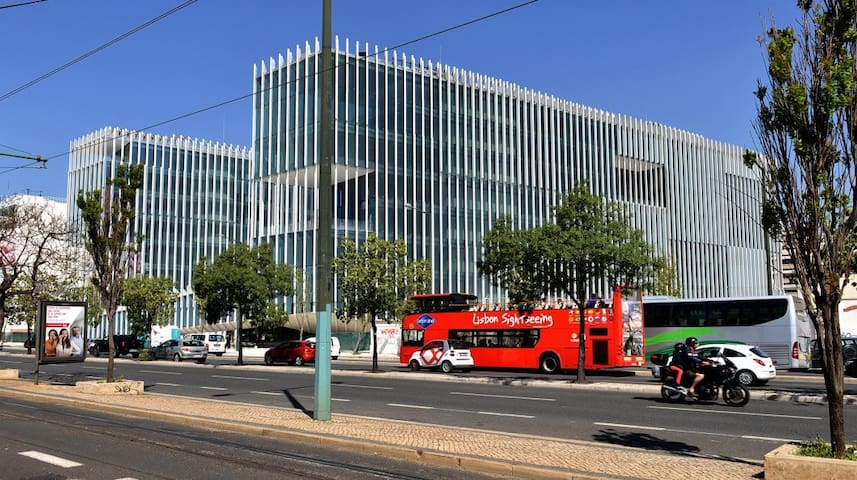Sightseeing
The Castelo de Sao Jorge stands majestically above Lisbon and is one of the finest tourist attractions in the city.
The castle is entwined in Lisbon’s early history; it saw the fall of the Romans to the Visigoths, experienced the fierce conflicts between the Arabs and Christians, survived formidable sieges by the Castilians and witnessed the birth of Portugal as a seafaring nation.
This varied and turbulent history is reflected throughout the castle. There are heavily fortified battlements, medieval royal quarters and seaward views, which inspired exploration within Portuguese kings.
1774 personas del lugar lo recomiendan
Castillo de San Jorge
Rua de Santa Cruz do CasteloThe Castelo de Sao Jorge stands majestically above Lisbon and is one of the finest tourist attractions in the city.
The castle is entwined in Lisbon’s early history; it saw the fall of the Romans to the Visigoths, experienced the fierce conflicts between the Arabs and Christians, survived formidable sieges by the Castilians and witnessed the birth of Portugal as a seafaring nation.
This varied and turbulent history is reflected throughout the castle. There are heavily fortified battlements, medieval royal quarters and seaward views, which inspired exploration within Portuguese kings.
Avenida da Liberdade has a history as one of Lisbon’s most eye-catching neighbourhoods, built as a park in the 18th century and converted in the late 19th century into the high-end boulevard that it is today. Designed in the image of Paris’s Champs-Elysees, it’s filled with grand buildings that house luxury shopping, five-star hotels, a range of restaurants and floral pedestrian walkways decorated with kiosk cafés and the traditional Portuguese tile.
621 personas del lugar lo recomiendan
Avenida da Liberdade
Avenida da LiberdadeAvenida da Liberdade has a history as one of Lisbon’s most eye-catching neighbourhoods, built as a park in the 18th century and converted in the late 19th century into the high-end boulevard that it is today. Designed in the image of Paris’s Champs-Elysees, it’s filled with grand buildings that house luxury shopping, five-star hotels, a range of restaurants and floral pedestrian walkways decorated with kiosk cafés and the traditional Portuguese tile.
The Praça dos Restauradores is central Lisbon’s most interesting plaza, which combines classical 17th century architecture with ornate art deco buildings. The square is often disregarded by many Portuguese but the Praça dos Restauradores offers tourists a section of varied and historically important sights and attractions.
At the centre of the square is the imposing Restauradores obelisk, which commemorates the independence of Portugal from Spain. Overlooking the obelisk is the sumptuous Palacio Foz with its distinctive pink exterior and grand interior. Next to the place is the stunning art deco Eden Theatre that has been converted into an exclusive hotel.
The fourth tourist attraction is the quaint Elevador da Gloria, a set of two carriages that climb the steep hill into the Bairro Alto district. The Praça dos Restauradores is varied, interesting and is rightly one of Lisbon’s finest plazas.
Restauradores Square
Praça dos RestauradoresThe Praça dos Restauradores is central Lisbon’s most interesting plaza, which combines classical 17th century architecture with ornate art deco buildings. The square is often disregarded by many Portuguese but the Praça dos Restauradores offers tourists a section of varied and historically important sights and attractions.
At the centre of the square is the imposing Restauradores obelisk, which commemorates the independence of Portugal from Spain. Overlooking the obelisk is the sumptuous Palacio Foz with its distinctive pink exterior and grand interior. Next to the place is the stunning art deco Eden Theatre that has been converted into an exclusive hotel.
The fourth tourist attraction is the quaint Elevador da Gloria, a set of two carriages that climb the steep hill into the Bairro Alto district. The Praça dos Restauradores is varied, interesting and is rightly one of Lisbon’s finest plazas.
Praça do Comércio (Commerce Square) is a large, historic square on the banks of the River Tagus in Lisbon. It was built on the site previously occupied by the Terreiro do Paço (Palace Yard) following its destruction in the 1755 earthquake. Lisboetas often still use the previous name for the square.
Along with the Arco da Rua Augusta at its northern end, the Praça do Comércio is one of the centerpieces of the redevelopment of the Baixa district of the Portuguese capital by the Marquis of Pombal in the mid-18th century.
717 personas del lugar lo recomiendan
Praça do Comércio
Praça do ComércioPraça do Comércio (Commerce Square) is a large, historic square on the banks of the River Tagus in Lisbon. It was built on the site previously occupied by the Terreiro do Paço (Palace Yard) following its destruction in the 1755 earthquake. Lisboetas often still use the previous name for the square.
Along with the Arco da Rua Augusta at its northern end, the Praça do Comércio is one of the centerpieces of the redevelopment of the Baixa district of the Portuguese capital by the Marquis of Pombal in the mid-18th century.
Jutting out of the water off the Belem riverfront, the quirky-looking Belém Tower is one of the most recognized of all Lisbon's tourist attractions and has become a symbol of the city. Completed in 1521, it originally functioned as a fortress to defend the mouth of the River Tagus and would have sat in the middle of the estuary (time and tide has shifted the river's course). The tower was built during the reign of King Manuel I and as such is regaled with plenty of Manueline architectural symbolism - carved stone maritime motifs like coiled and twisted rope, armillary spheres, and the Cross of the Order of Christ, a military order that helped finance early voyages of discovery.
217 personas del lugar lo recomiendan
Belém
Jutting out of the water off the Belem riverfront, the quirky-looking Belém Tower is one of the most recognized of all Lisbon's tourist attractions and has become a symbol of the city. Completed in 1521, it originally functioned as a fortress to defend the mouth of the River Tagus and would have sat in the middle of the estuary (time and tide has shifted the river's course). The tower was built during the reign of King Manuel I and as such is regaled with plenty of Manueline architectural symbolism - carved stone maritime motifs like coiled and twisted rope, armillary spheres, and the Cross of the Order of Christ, a military order that helped finance early voyages of discovery.
Among the most celebrated historic monuments in Portugal, the Jerónimos monastery is also one of the jewels in Lisbon's sightseeing crown. Commissioned by King Manuel I in 1501 and timed to coincide with the return of Vasco da Gama (1460-1524) after his momentous voyage to India, the church and adjacent monastery are considered the greatest examples of Manueline architecture in the country. The church's south portal is astonishing in its detail, with no less than 40 statues of ornate filigree embellishing the entrance. Inside, the nave is equally exuberant, the vaulting carved to resemble giant palms fanning out from slender octagonal pillars. Several royal tombs are placed in and around the chancel, including those of Manuel himself and King João III. Laid to rest nearer the entrance are Vasco da Gama and the poet Luís de Camões. Architect Diogo de Boitaca was originally tasked with designing the building but the sumptuous carved stone arches and balustrades in the cloister are the work of João de Castilho, who replaced de Boitaca in 1517. The monastery was occupied by the Order of St. Jerome (Hieronymites) until 1834.
894 personas del lugar lo recomiendan
Monasterio de los Jerónimos
Among the most celebrated historic monuments in Portugal, the Jerónimos monastery is also one of the jewels in Lisbon's sightseeing crown. Commissioned by King Manuel I in 1501 and timed to coincide with the return of Vasco da Gama (1460-1524) after his momentous voyage to India, the church and adjacent monastery are considered the greatest examples of Manueline architecture in the country. The church's south portal is astonishing in its detail, with no less than 40 statues of ornate filigree embellishing the entrance. Inside, the nave is equally exuberant, the vaulting carved to resemble giant palms fanning out from slender octagonal pillars. Several royal tombs are placed in and around the chancel, including those of Manuel himself and King João III. Laid to rest nearer the entrance are Vasco da Gama and the poet Luís de Camões. Architect Diogo de Boitaca was originally tasked with designing the building but the sumptuous carved stone arches and balustrades in the cloister are the work of João de Castilho, who replaced de Boitaca in 1517. The monastery was occupied by the Order of St. Jerome (Hieronymites) until 1834.
This iconic piece of modern architecture on the waterfront was designed by British architect Amanda Levete and opened in the fall of 2016. It stands next to a former power plant which was previously the Electricy Museum, and that is now also part of the Museum of Art, Architecture and Technology. Both buildings present temporary exhibitions of major international and local artists, directed by the former curator of contemporary architecture of New York’s MoMA.
It's possible to walk over the building, which serves as a beautiful lookout terrace, while a series of steps by the entrance descend toward the river.
529 personas del lugar lo recomiendan
MAAT
Avenida BrasíliaThis iconic piece of modern architecture on the waterfront was designed by British architect Amanda Levete and opened in the fall of 2016. It stands next to a former power plant which was previously the Electricy Museum, and that is now also part of the Museum of Art, Architecture and Technology. Both buildings present temporary exhibitions of major international and local artists, directed by the former curator of contemporary architecture of New York’s MoMA.
It's possible to walk over the building, which serves as a beautiful lookout terrace, while a series of steps by the entrance descend toward the river.
Food scene
Rossio is the liveliest square in the city, where people stop to sit and relax, or for a drink at the several atmospheric cafés with outdoor sitting.
On either side of the square are two baroque fountains, and in the center is a monument measuring 27 meters in height. It consists of a pedestal with marble allegories of Justice, Wisdom, Strength, and Moderation, qualities attributed to Dom Pedro IV, whose statue stands on top of the monument.
In the 19th century, the square was paved with cobblestones in wave patterns, a design seen today in many other pavements all over Portugal, and that has spread to Portugal's former colonies from Rio de Janeiro (Brazil) to Macao (China).
On the north side of the square is the Dona Maria II National Theater, a monumental neoclassical building built in the 1840s. The portico has six Ionic columns (originally from the Church of St. Francis, destroyed in the 1755 earthquake), and crowning the pediment is a statue of playwright Gil Vicente.
397 personas del lugar lo recomiendan
Rossio Square
Rossio is the liveliest square in the city, where people stop to sit and relax, or for a drink at the several atmospheric cafés with outdoor sitting.
On either side of the square are two baroque fountains, and in the center is a monument measuring 27 meters in height. It consists of a pedestal with marble allegories of Justice, Wisdom, Strength, and Moderation, qualities attributed to Dom Pedro IV, whose statue stands on top of the monument.
In the 19th century, the square was paved with cobblestones in wave patterns, a design seen today in many other pavements all over Portugal, and that has spread to Portugal's former colonies from Rio de Janeiro (Brazil) to Macao (China).
On the north side of the square is the Dona Maria II National Theater, a monumental neoclassical building built in the 1840s. The portico has six Ionic columns (originally from the Church of St. Francis, destroyed in the 1755 earthquake), and crowning the pediment is a statue of playwright Gil Vicente.
oceanarium
Not only is this one of the largest aquariums in the world, it's also one of the best designed. Although the over 25,000 sea creatures seem to be swimming together, sharks are separated from smaller defenseless fish by invisible acrylic walls. It's the first aquarium to place all world ocean habitats together, and presents several marine species, from the curious round stingrays to the giant sunfish, seahorses, otters and penguins... In 2017 it inaugurated a new sardine tank.
The main building, rising from the Tagus, was built for the 1998 World Fair, while an annex was inaugurated in 2011 to house sea turtles.
The main attraction is the gigantic tank visible from four different levels, where high-tech displays explain everything in different languages.
571 personas del lugar lo recomiendan
Oceanario de Lisboa
s/nº Esplanada Dom Carlos INot only is this one of the largest aquariums in the world, it's also one of the best designed. Although the over 25,000 sea creatures seem to be swimming together, sharks are separated from smaller defenseless fish by invisible acrylic walls. It's the first aquarium to place all world ocean habitats together, and presents several marine species, from the curious round stingrays to the giant sunfish, seahorses, otters and penguins... In 2017 it inaugurated a new sardine tank.
The main building, rising from the Tagus, was built for the 1998 World Fair, while an annex was inaugurated in 2011 to house sea turtles.
The main attraction is the gigantic tank visible from four different levels, where high-tech displays explain everything in different languages.
Night life
In some of Lisbon’s oldest and most traditional neighbourhoods, you’ll find a nightlife and festive spirit that you’ll find hard to believe in the centre of the city. The streets fill with people of all ages who come to catch up, have a drink, watch the people passing by and discover all the many new things there are to be found.
There’s little point asking a Lisboeta where the best place is to go out at night. The whole city meets at the centre of its nightlife, where there are places to suit every taste and music for every genre. The more experienced guarantee that Lisbon’s nightlife consists of a steady downhill motion – and the more poetic of them swear that every conversation is spoken in italics. Why? Because it always begins in Bairro Alto with its many and varied bars and restaurants, then heads down to Bica with a glass in hand and always ends in Cais do Sodré, where the most popular nightclubs intermingle with the old sailors’ bars, combining an original mix of cultures and ambiances. Whether you like 80s classics, hard rock or the freshest of musical sounds, you’re bound to find something that’s tailored to suit your tastes.
During the day, Bairro Alto is home to various alternative shops, from records to art and hairdressers.
1835 personas del lugar lo recomiendan
Bairro Alto
21 Tv. InglesinhosIn some of Lisbon’s oldest and most traditional neighbourhoods, you’ll find a nightlife and festive spirit that you’ll find hard to believe in the centre of the city. The streets fill with people of all ages who come to catch up, have a drink, watch the people passing by and discover all the many new things there are to be found.
There’s little point asking a Lisboeta where the best place is to go out at night. The whole city meets at the centre of its nightlife, where there are places to suit every taste and music for every genre. The more experienced guarantee that Lisbon’s nightlife consists of a steady downhill motion – and the more poetic of them swear that every conversation is spoken in italics. Why? Because it always begins in Bairro Alto with its many and varied bars and restaurants, then heads down to Bica with a glass in hand and always ends in Cais do Sodré, where the most popular nightclubs intermingle with the old sailors’ bars, combining an original mix of cultures and ambiances. Whether you like 80s classics, hard rock or the freshest of musical sounds, you’re bound to find something that’s tailored to suit your tastes.
During the day, Bairro Alto is home to various alternative shops, from records to art and hairdressers.
K Urban Beach
Cais da ViscondessaThis busy avenue runs parallel to the river and is known for its bars and clubs. Unfortunately, it's a long avenue that looks more like a highway, blocking your way to the riverfront, as do the train tracks next to it. To cross it and reach the river or the clubs, you must use the few crosswalks and the overpasses over the tracks.
The avenue starts in Cais do Sodré by the Ribeira Market, and goes through the Santos neighborhood before ending in the Alcântara district. In between are several office and apartment buildings, and two of the city's top museums, the Ancient Art Museum and the Orient Museum.
158 personas del lugar lo recomiendan
Santos station
Avenida 24 de JulhoThis busy avenue runs parallel to the river and is known for its bars and clubs. Unfortunately, it's a long avenue that looks more like a highway, blocking your way to the riverfront, as do the train tracks next to it. To cross it and reach the river or the clubs, you must use the few crosswalks and the overpasses over the tracks.
The avenue starts in Cais do Sodré by the Ribeira Market, and goes through the Santos neighborhood before ending in the Alcântara district. In between are several office and apartment buildings, and two of the city's top museums, the Ancient Art Museum and the Orient Museum.

